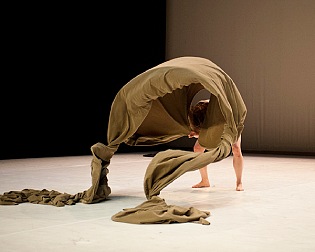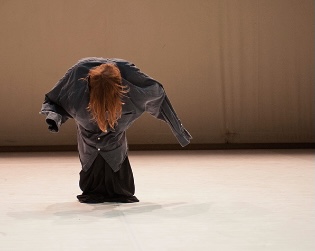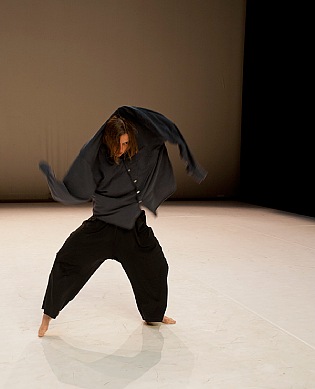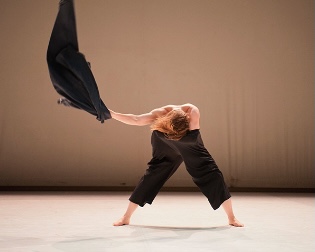“How are the formulation of our sensations, the study of the physical and anatomical systems offering new territories in research to dancers? One possible answer could be found in the piece An Un-Folding Process (excerpts from Unturtled till Der Bau) by Isabelle Schad, in which the enormous fabrics and a costume conceived together with visual artist Laurent Goldring become a new internal space of the body, a gigantic imaginary skin. The body envelopes and incorporates. The dance is born from the integration of the spaces between skin and tissues.
Read more
The dances are punctuated with lectures. Isabelle Schad is exposing her notes of work and her thoughts and includes the spectator in this immense matrix. The work is as much visual as knowing; the sensation of making oneself part of a strange organ invites the spectator to see the piece from the inside. And this is where all the beauty of the work operates in the surprising cross-over between Franz Kafka and the American avant-garde of dance.”
Stéphanie Auberville
French text:
“Embodied conversations, le workshop de Trude Cone et Ka Rustler s’inscrit aussi dans cette démarche et questionne la relation entre mouvements internes du corps, pensée et langage. Comment la formulation de sensations, l’étude de systèmes physiques et anatomiques offrent aux danseurs de nouveaux territoires de recherches ?
Une réponse possible peut être trouvée dans la pièce d’Isabelle Schad Excerpts from der Bau où les immenses tissus et costumes du plasticien Laurent Goldring deviennent de nouveaux espaces internes du corps, de gigantesques peaux imaginaires. Le corps englobe, incorpore. La danse naît de cette intégration des espaces entre peau et tissus. Les danses sont ponctuées de lectures. Isabelle Schad expose ses notes de travail et ses pensées et ce faisant inclut le spectateur dans cette immense matrice. Si visuellement le travail est saisissant, la sensation de faire partie d’un étrange organe invite le spectateur à voir la pièce de l’intérieur. Et c’est là toute la beauté de ce travail qui opère un croisement étonnant entre Franz Kafka et l’avant garde américaine.”
Stéphanie Auberville
Notes on a Bangkok’s long weekend: What could possibly relate to notions of city, choreography and curating?
A quick browse after I returned from my recent trip to Bangkok – the first in eight years – reveals some similarities between the city and my hometown Jakarta. Both capitals, apparently, are a primate city, a categorical descriptor in urban studies referring to the leading city in its country or region which is disproportionately larger than others in the urban hierarchy. Coined by geographer Mark Jefferson in 1939, the term defines the primate city being at least twice as large as the next largest city in the country – and Bangkok is 18 times larger than Thailand’s next big city – and more than twice as significant.
Both Bangkok and Jakarta fit the bill. Up until the late 1990s, the two cities were compared for competing to win the notorious trophy of the worst traffic in the region. However, five years into the new century, just around my first visit to Bangkok in 2005, the city had seemed to pull herself together, successfully running the newly-built subways and commuter train network, leaving Jakarta behind in betterment. Although, both cities were still sharing acute urban problems like flooding and arguably, both being a site of ongoing political tension however different in nature.
Bangkok was built on and around canals. Interestingly, Jakarta’s modernity was instigated by the colonial Dutch through the redesign of the port city of Batavia, with canals resembling those in Amsterdam, thus making the primate city allegory sound. Bangkok is always on the move, growing, expanding; extending and unfolding itself, a space not so dissimilar to an organ, or a body itself. I have embodied the pulsating Jakarta’s daily chaos and perhaps, this has informed me well to traverse Bangkok’s streets – the maze of soi and sol, potholes and the variety of its irregular pedestrian contours.
I was in town only shortly, for a specific purpose. Taking place in a long weekend of 19-22 November, my trip was for watching parts of Unfolding Kafka Festival, focusing on two related solo performances by Berlin-based choreographer Isabelle Schad who collaborates with Laurent Goldring, a Paris-based visual artist. I chose to see the two works, Der Bau (The Burrows) and An Un-folding Process. The first was a full-length solo piece performed at a nice black box theatre in the Drama Department of the Chulalangkorn University, the second a lecture- performance performed at the Burapha University in Chonburi – a beach town just an hour and half outside Bangkok.
The festival’s curator, Jitti Chompee of 18 Monkeys Dance Theatre, designed the festival around the literary work of Franz Kafka. His curatorial approach sounded like an unfolding process in itself, it started with him watching Der Bau in Hamburg last year. Having never heard of Kafka before, he was intrigued by the piece, something he had actually struggled to understand. He approached Schad who then urged him to also meet her collaborator, Goldring; and Chompee followed suit. These encounters and his own effort to access Kafka’s work through a scholar at home led to the Unfolding Kafka Festival.
The festival was smallish and compact. Running across three weeks (12 November to 3 December 2015), it offered the above-mentioned double bill by Schad-Goldring, Silence of the Insects, a new commission of collaborative installation-performance at a commercial hotel (Chompee and scenographer Yoko Seyama), a workshop on Embryology and Eastern Practices by Schad and closed with Cesser d’être (Stop Being), a string sculpture-performance by Laurent Goldring, Chompee himself and Marika Rizzi.
On Body, Spaces and Other Things in Between
Der Bau is based on Franz Kafka’s novella. It narrates a creature which builds a nest that extends from its body, until the nest became part of his body, of himself. On a dim-lit stage, the choreography starts with Schad standing at the upper right corner from the audience’s view, her lithe figure bending over, with eyes staring at her navel. What was facing us – the audience – is her fontanel. Her body radiates a rather strange shape, genderless; its presence underlines her physicality through minimal, economical movement. The lighting remains foggy throughout, but once our eyes get used to it, the stage reveals the muscles of her upper back, positioned upside down. Her hand movements reveal these muscles, protruding slowly and intensely. She negotiates the problem of nudity surprisingly well, cupping her breasts with skin-coloured cloth that leave her back entirely bare without any bra string, leaving the impressive portruding sequence un-spoilt.
From this small but intense opening, Schad shifts smoothly across the stage. From three different points on stage, she picks up a sheet of long fabric, each with slightly different shades and textures. What unfolds is a curious series of imageries, which takes time to register. The axial body and the fabrics gradually create space in between, the relationship between the two shifts and proposes different associations. At first, the body resembles a prosthesis, the fabric like another layer of the skin before the space, turning as if its an organ, blurring the borders between the two. She lets herself become engulfed and thus trans-formed.
In the post-performance talk, Schad explained about the inner-outer spaces she tries to consciously connect in the piece. Audience reception – absorbed, engaged – betraying the slight scepticism of those who think that such piece is not typically Bangkok’s stage fare.
To Chonburi
The next day I travelled to Chonburi where Schad was scheduled to give a workshop to a dozen dance students before performing Un-folding Process, a lecture-performance. The students were young, and terribly open to embracing Schad’s proposal on Embryology and Eastern Practices. It’s more about a phenomenological approach to being in a body and how it relates to other bodies in the space rather than an afternoon learning a new dance technique or choreographic approach. She told me that she wanted to ’warm up’ the theatre, hence she asked the workshop to take place right on the site.
Chonburi is one of the peripheral spots for Bangkokians to go for short holidays. The college is a five-minute drive from the white-sand beach, which is lined with tourist facilities – bungalows, cafes, food stalls and more. The lecture-performance took place in the afternoon, and in the piece, one could trace a brief trajectory of ideas that resulted in the series of works Schad created with Goldring over the years, from Unturtled to Der Bau.
In between reading her notes – whose Thai translation was given away to the audience beforehand – Schad demonstrated excerpts of the choreographic pieces of the series. The lecture-performance was an intimate space, with its simple and almost bare staging. If curating is about criticality, Chompee did his best to simply follow his curiosity line, one after the other, thus connecting different nodes of partners- presenters, e.g. Goethe-Institut, Japan Foundation, the two universities and a commercial hotel. As an independent curator, in a place where curating performance is yet to become a familiar practice let alone a profession, I share Chompee’s excitement of realising what was once a mere flickering idea. With its sprawling urban space, predominately dictated by capitalistic power, mainstream, primate cities like Bangkok and Jakarta are much in need of such organic intervention, of which a space for other narratives to take place can emerge.
Helly Minarti







